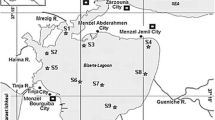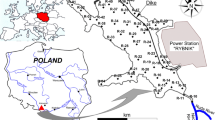Abstract
We compared sediment quality in estuaries at three locations along the coast of São Paulo State, Brazil, using geochemical analyses and whole sediment toxicity tests, during the southern summer and winter of 2013. Each locality is afforded a distinct degree of legal protection, and exhibits a different level of metal pollution: overall, Rio Diana (RD, the most polluted, a Permanent Protection Area) > Rio Itapanhaú (RI, intermediate contamination, an Environmental Protection Area) > Rio Picinguaba (RP, pristine, a State Park). Chronic sediment toxicity tests evaluated reproductive rates of the copepod Nitokra sp. RI sediments showed the highest metal concentrations and toxicity in both seasons. Metal concentrations at RD were low but toxic in summer. RP sediments were not contaminated, suggesting effective legal protection from pollution at this locality. RI and RD, although provided some legal protection, showed clear signs of environmental degradation, emphasizing the need for more effective pollution control.



Similar content being viewed by others
References
Abessa DMS, Vicente TM, Moreira LB, Morais LG, Cruz ACF, Massoneto M, Campos BG, Bícego MC, Taniguchi S, Hortellani MA, Sarkis JES (2017) Assessing the sediment quality of the Laje de Santos Marine State Park and other marine protected areas from the central coast of São Paulo (Brazil). Braz J Oceanogr 65(4):532–548. https://doi.org/10.1590/s1679-87592017128606504
Abessa DM, Albuquerque HC, Morais LG, Araujo GS, Fonseca TG, Cruz AC et al (2018) Pollution status of marine protected areas worldwide and the consequent toxic effects are unknown. Environ Pollut 243:1450–1459
Abessa DMS, Rachid BRF, Zaroni LP, Gasparro MR, Pinto YA, Bícego MC, Hortellani MA, Sarkis JES, Muniz P, Sousa ECPM (2019) Natural factors and chemical contamination control the structure of macrobenthic community in the Santos Estuarine System (SP, Brazil). Community Ecol 20(2):121–137. https://doi.org/10.1556/168.2019.20.2.3
Adams SM, Crumby WD, Greeley Jr MS, Ryon MG, Schilling EM (1992) Relationships between physiological and fish population responses in a contaminated stream. Environ Toxicol Chem Int J 11(11):1549–1557
Brasil (2000) Lei No 9.985, de 18 de Julho de 2000. Regulamenta o art. 225, § 10, incisos I, II, III e VII da Constituição Federal, institui o Sistema Nacional de Unidades de Conservação da Natureza e dá outras providências. http://www.planalto.gov.br/ccivil_03/leis/l9985.htm. Accessed 1 Aug 2020
Capparelli MV, Gusso-Choueri PK, de Souza ADM, McNamara JC (2019) Seasonal environmental parameters influence biochemical responses of the fiddler crab Minuca rapax to contamination in situ. Comp Biochem Physiol Part C Toxicol Pharmacol 216:93–100
CCME (2001) Canadian water quality guidelines for the protection of aquatic life: Canadian Water Quality Index 1.0 Technical Report. In Canadian environmental quality guidelines, 1999. Winnipeg, Manitoba
CETESB (2006) Águas interiores. Rede de monitoramento de qualidade das águas interiores do Estado de São Paulo. Relatórios. https://www.cetesb.sp.gov.br/aguas-interiores/publicacoes-e-relatorios/. Accessed 23 Nov 2020
CETESB (1985) Resíduos sólidos industriais. Série Atlas da CETESB, São Paulo, pp 92–93
CETESB (2018) Decisão de diretoria Nº 256/2016/E, de 22 de novembro de 2016
Chapman PM (1995) Ecotoxicology and pollution—key issues. Mar Pollut Bull 31(4–12):167–177
Choueri RB, Cesar A, Abessa DMDS, Torres RJ, Morais RD, Riba I, DelValls TA (2009) Development of site-specific sediment quality guidelines for North and South Atlantic littoral zones: comparison against national and international sediment quality benchmarks. J Hazard Mater 170(1):320–331
Cruz ACF, Gusso-Choueri P, de Araujo GS, Campos BG, de Sousa Abessa DM (2019) Levels of metals and toxicity in sediments from a Ramsar site influenced by former mining activities. Ecotoxicol Environ Saf 171:162–172
Cunha-Lignon M, Coelho C Jr, Almeida R, Menghini R, Correa F, Schaeffer-Novelli Y et al (2009) Mangrove forests and sedimentary processes on the South of Coast of São Paulo State (Brazil). J Coast Res 1:405–409
Eichler PPB, Eichler BB, David CJ, de Miranda LB, Sousa ECPM (2006) The estuary ecosystem of Bertioga, São Paulo, Brazil. J Coastal Res II:1110–1113
Ferraz MA, Alves AV, de Cássia Muniz C, Pusceddu FH, Gusso-Choueri PK, Santos AR, Choueri RB (2017) Sediment toxicity identification evaluation (TIE phases I and II) based on microscale bioassays for diagnosing causes of toxicity in coastal areas affected by domestic sewage. Environ Toxicol Chem 36(7):1820–1832
Gonçalves C, Figueira RCL, Sartoretto JR, Salaroli AB, Ribeiro AP, Ferreira PA, Mahiques MMD (2013) Reconstruction of historical trends in potentially toxic elements from sediment cores collected in Bertioga channel, southeastern Brazil. Braz J Oceanogr 61(2):149–160
Gusso-Choueri PK, de Araújo GS, Cruz ACF, de Oliveira Stremel TR, de Campos SX, de Souza Abessa DM, Choueri RB (2018) Metals and arsenic in fish from a Ramsar site under past and present human pressures: consumption risk factors to the local population. Sci Total Environ 628:621–630
IBGE (2007) Fundação Instituto Brasileiro de Geografia e Estatística. Rio de Janeiro
IUCN (1994) Guidelines for protected area management categories. CNPPA with the assistance of WCMC. IUCN, Gland
Kelleher G (1999) Guidelines for marine protected areas. IUCN, Gland
Kelleher K (2005) Discards in the world’s marine fisheries: an update. Food & Agriculture Org., Rome
Loring DH, Rantala RT (1992) Manual for the geochemical analyses of marine sediments and suspended particulate matter. Earth-Sci Rev 32(4):235–283
Lotufo GR, Abessa DM (2002) Testes de toxicidade com sedimento total e água intersticial estuarinos utilizando copépodos bentônicos. Métodos em Ecotoxicol Mar 13:151–162
Luiz-Silva W, Matos RHR, Kristosch GC, Machado W (2006) Variabilidade espacial e sazonal da concentração de elementos-traço em sedimentos do sistema estuarino de Santos-Cubatão (SP). Química Nova 29:256
Moreira LB, Camargo JB, Marques BB, Martins CC, Abessa DM (2019a) Evaluating multiple lines of evidence of sediment quality in an urban Marine Protected Area (Xixová-Japuí State Park, SP, Brazil). Environ Sci Pollut Res 26(5):4605–4617. https://doi.org/10.1007/s11356-018-3941-7
Moreira LB, Leite PR, Dias ML, Martins CC, Abessa DM (2019b) Sediment quality assessment as potential tool for the management of tropical estuarine protected areas in SW Atlantic, Brazil. Ecol Ind 101:238–248. https://doi.org/10.1016/j.ecolind.2018.12.052
Perina FC, Torres RJ, Mozeto AA, Nascimento MRL, de Souza Abessa DM (2018) Sediment quality assessment of the tributaries of the Santos-São Vicente Estuarine System–Brazil. Ecotoxicol Environ Contam 13(2):25–38
Pozo HV, Davanso MB, Moreira LB, Abessa DMS (2011) Toxicidade aguda de sedimentos na área de influência de uma marina no canal da Bertioga. IN. Simpósio Brasileiro de Oceanografia, 5
R Core Team (2017) R: a language and environment for statistical computing. R Foundation for Statistical Computing, Vienna, Austria. URL https://www.R-project.org/. Accessed 23 Nov 2020
Ribeiro TS, Carvalho DP, Guimarães MT, Campina NN, Lobarinhas MR, Lopes ALJ et al (2016) Prevalence of hypertension and its associated factors in contaminated areas of the Santos-São Vicente Estuarine region and Bertioga, Brazil: 2006–2009. Environ Sci Pollut Res 23(19):19387–19396
Rodrigues SK, Abessa DM, Machado EC (2013) Geochemical and ecotoxicological assessment for estuarine surface sediments from Southern Brazil. Mar Environ Res 91:68–79
São Paulo, Estado (1977) Decreto No 10.251, de 30 de Agosto de 1977. Cria o Parque Estadual da Serra do Mar e dá providências correlatas. http://www.al.sp.gov.br/repositorio/legislacao/decreto/1977/decreto-10251-30.08.1977.html. Accessed 1 Aug 2020
São Paulo, Estado (2008a) Decreto No 53.526, de 08 de Outubro de 2008. Cria a Área de Proteção Ambiental Marinha do Litoral Centro, e dá providências correlatas. https://www.al.sp.gov.br/repositorio/legislacao/decreto/2008/decreto-53526-08.10.2008.html. Accessed 1 Aug 2020
São Paulo, Estado (2008b) Decreto No 53.528, de 8 de Outubro de 2008. Cria o Mosaico das Ilhas e Áreas Marinhas Protegidas do Litoral Paulista, e dá providências correlatas. https://www.al.sp.gov.br/repositorio/legislacao/decreto/2008/decreto-53528-08.10.2008.html. Accessed 1 Aug 2020
Schubauer-Berigan MK, Dierkes JR, Monson PD, Ankley GT (1993) pH-dependent toxicity of Cd, Cu, Ni, Pb and Zn to Ceriodaphnia dubia, Pimephales promelas, Hyalella azteca and Lumbriculus variegatus. Environ Toxicol Chem: Int J 12(7):1261–1266
Sousa ECPMD, Zaroni LP, Gasparro MR, Pereira CDS (2014) Review of ecotoxicological studies of the marine and estuarine environments of the Baixada Santista (São Paulo, Brazil). Braz J Oceanogr 62(2):133–147
Wentworth CK (1922) A scale of grade and class terms for clastic sediments. J Geol 30(5):377–392
Wren CD, Stephenson GL (1991) The effect of acidification on the accumulation and toxicity of metals to freshwater invertebrates. Environ Pollut 71(2–4):205–241
Zaroni LP (2006) Avaliação da qualidade dos sedimentos marinhos e estuarinos no município de Bertioga-SP (Doctoral dissertation)
Acknowledgements
This investigation received financial support from the Fundação de Amparo à Pesquisa do Estado de São Paulo (#2011/22537-0 to JCM) and from which MVC received a doctoral scholarship (#2011/08065-9). JCM (300662/2009-2) and DMSA (308649/2011) received Excellence in Research scholarships from the Conselho Nacional de Desenvolvimento Científico e Tecnológico, Brazil. We are most grateful to Dr Gabriel Massaine Moulatlet (IKIAM) for preparing the site maps. Dr. Fernando Barbosa kindly provided access to the metal analysis facilities at the Departamento de Análises Clínicas, Toxicológicas e Bromatológicas, Faculdade de Ciências Farmacêuticas, Universidade de São Paulo in Ribeirão Preto.
Author information
Authors and Affiliations
Corresponding author
Ethics declarations
Conflict of interest
The authors declare that they have no known competing financial interests or personal relationships that could influence the present investigation.
Additional information
Publisher's Note
Springer Nature remains neutral with regard to jurisdictional claims in published maps and institutional affiliations.
Rights and permissions
About this article
Cite this article
Capparelli, M.V., McNamara, J.C., Araujo, G.S. et al. Use of an Integrated Geochemical and Ecotoxicological Approach to Evaluate Sediment Metal Contamination in Three Protected Estuarine Areas Along the Coast of São Paulo State, Brazil. Bull Environ Contam Toxicol 106, 355–362 (2021). https://doi.org/10.1007/s00128-020-03076-5
Received:
Accepted:
Published:
Issue Date:
DOI: https://doi.org/10.1007/s00128-020-03076-5




